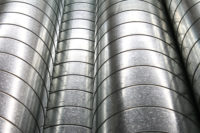Construction Inputs
US Construction Materials Prices Increase Month to Month in April, But Remain Historically Low

Materials prices have now decreased on a year-over-year basis for 17 consecutive months.
Image courtesy of Pixabay
Construction input prices expanded on a monthly basis for the second consecutive month in April, increasing by 0.5%, according to the most recent Bureau of Labor Statistics Producer Price Index.
The two-month growth streak follows nine consecutive months during which construction input prices fell, and construction input prices remain 2.9% below their April 2015 levels.
Prices have now decreased on a year-over-year basis for 17 consecutive months. Nonresidential construction inputs behaved similarly, expanding 0.5% month-over-month but falling 3.1% year-over-year.
Eight key input prices rose in April on a monthly basis:
- Crude petroleum prices expanded 17.6% from March 2016 but are down 22.4% from April 2015.
- Unprocessed energy material prices rose 9% on a monthly basis but fell 18.2% on a year-ago basis.
- Prices for steel mill products are up 2% on a monthly basis but down 11.3% on a yearly basis.
- Iron and steel prices expanded 4.9% month-over-month but declined 8.6% year-over-year.
- Softwood lumber prices grew 2.7% for the month and 1.8% from April 2015.
- Concrete product prices expanded by 0.7% month-over-month and are up 3.1% year-over-year.
- Natural gas prices increased 8.4% for the month but are down 25.7% from the same period a year ago.
- Fabricated structural metal prices products rose 0.2% month-over-month but decreased 2% year-over-year.
Three key input prices declined on a monthly basis:
- Prices for prepared asphalt and tar and roofing and siding products fell by 1.9% from March 2016 and are down 1.5% from April 2015.
- Prices for plumbing fixtures and fittings fell 0.1% for the month but are up 0.1% from the same time last year.
- Nonferrous wire and cable prices fell 0.3% on a monthly basis and 6.1% on a yearly basis.
Analysis
“Despite the end of month-to-month materials price decreases, prices remain low by historic standards and will likely continue to do so for the foreseeable future,” said Associated Builders and Contractors Chief Economist Anirban Basu.
“Commodity prices, including oil prices, have been edging higher lately in response to a number of potentially temporary phenomena, including a weakening U.S. dollar. “Coming into the year, the presumption among many market participants was that U.S. interest rates would rise meaningfully, thereby increasing the value of the dollar. Contrary to expectations, interest rates have not risen significantly, and the dollar has been weakening in response,” he said.
“That has helped to set the stage for the recent bounce-back in oil and certain other commodity prices,” Basu added. “Other factors have not been as supportive, including a still-weak global economy. Global economic weakness is likely to persist, and the dollar may begin to strengthen again. This means that construction firm managers should not assume that oil and other prices will rise steadily.
“In fact, reversals in commodity prices remain quite possible. While oil prices have risen sharply since lows achieved earlier this year, copper, natural gas and other prices have expanded only modestly. The next materials price report could easily show further inflation. The story of inexpensive materials will continue to be told,” Basu said.

